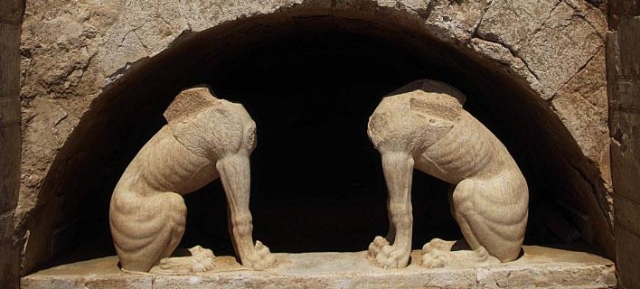photos www.iefimerida.gr
The established assumptions of archaeologists about the Kasta hill and the Amphipolis tomb were shaken by the report of Evangelos Kambouroglou, director of the Palaeoanthropology and Speleology Ephorate, department of archaeological research, and member of the scientific team of Amphipolis excavations, at the 28th Archaeological Congress on Macedonian and Thracian archaeology at the Aristotle University of Thessaloniki.

Kambouroglou’s report, entitled "The sediments of the Kasta hill in Amphipolis and their relationship with the headstone", claimed that "no data confirm that the Lion of Amphipolis was located on the Kasta hill". This conclusion, as is well-known, was reached about two years ago by excavation team leader, archaeologist Katerina Peristeri, and her assistant, architect Michalis Lefantzis. While making his case, Kambouroglou presented the following evidence:
1. The Kasta tomb hill is natural, not artificial.
2. It consists of sediments of quartzite sand, clay and sandstone, which give it a limited durability and render it unable to support any weight over 500 tons - and the pedestal and sculpture of the Lion alone exceed a total of 1,500 tons.
3. The tomb on the Kasta hill was built at a later time than the main monument, and is ‘a cheap construction’ that does not fit in with the surrounding monument.

Kambouroglou, who had worked closely with chief site archaeologist Katerina Peristeri at the beginning of the digging works on the Kasta hill, said that when he had entered the burial chamber (he was the first one to do so), “there were many human interventions and burnt remains (samples of which have been sent to a Massachusetts institute for analysis, but results have yet to come), while its roof showed the earth had shifted,” possibly from the same earthquake as that of 597 AD, which is thought to have been so strong (estimated at 6.7 on the Richter scale) that it changed the direction of the of Strymon River flow.

University of Thessaloniki physics professor Grigoris Tsokas, also involved in the excavation’s analysis, said during his talk that the construction of the perivolos, or low wall surrounding the monument, has created problems in the earth layering and made it impossible to use imaging technology.
The congress, held annually to present results from excavations and research of sites in northern Greece, is wrapping up its second and last day without any other scientific reports on the already legendary excavations on the Kasta hill in Amphipolis. On Friday, the presenters had announced that Peristeri would not be making any statements as the results of the research are not yet out and they made special mention of the global media frenzy created around the excavation.
It has been reported that the decision of the geologist cum speleologist Kambouroglou to present a paper on this topic has specifically annoyed Katerina Peristeri.